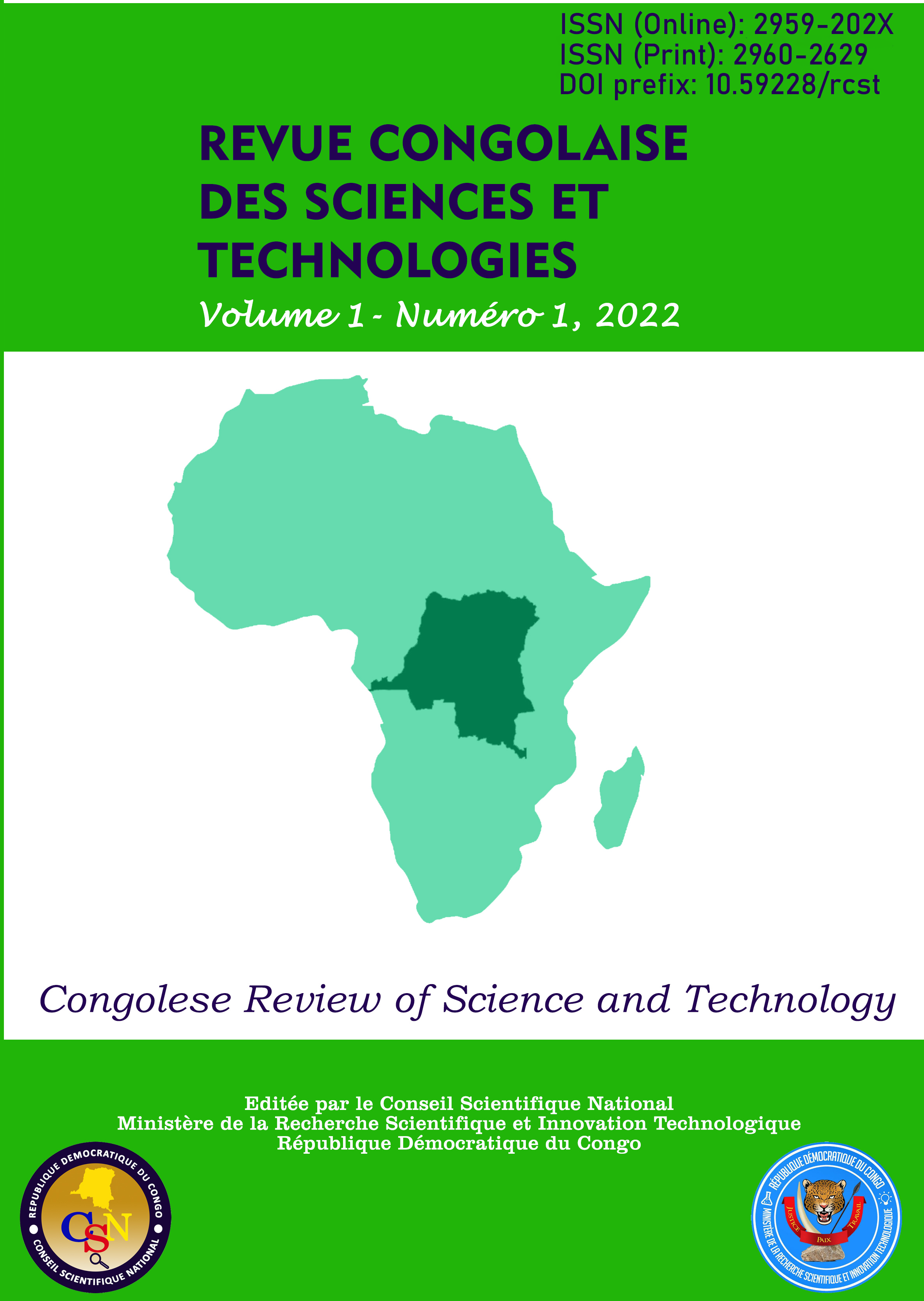Sexual behaviour and unwanted pregnancies in schools-Uvira city: KAP study Nuru and Zawadi ya Raisi institutes in Uvira
Main Article Content
Abstract
The purpose of this work is to know the causes responsible for the incidence of unwanted pregnancies in schools. On the one hand, it is a question here of determining the level of knowledge of secondary school students in the city of Uvira on sexual and reproductive health, discovering risky sexual attitudes and behaviors but also determining their level of use of methods prevention of unwanted pregnancies. This is a cross-sectional descriptive study covering the period from September 2010 to June 2011. The study focused on 110 students from the 1st to 6th secondary years of the Nuru and Zawadi ya Raisi institutes in Uvira. It appears from this study that 72.8% know the menstrual cycle and its meaning; 63.5% know the average length of the menstrual cycle and 91% claim to know is that unwanted pregnancy. The fertile period is ignored by young people at 54%. As for knowledge of contraception, 73% of young people have no knowledge of contraceptives apart from the definition of this concept, while 79% of respondents claim to be sexually active, and of these 63% confirm that they are not have never used any contraceptive method. Faced with this low level of knowledge among young people, and their risky sexual practices, joint action by parents, the health system and the education system is necessary in order to considerably reduce the extent of this phenomenon, for fear of seeing all schooling efforts.
Article Details

This work is licensed under a Creative Commons Attribution-NonCommercial-ShareAlike 4.0 International License.
References
Adjahoto, K.A.S., Hodonou, E.O, K., Kodo, K., Akpadza, S., Baeta., (1999). Connaissances, attitudes et pratiques des enseignants mariés de la commune de Lome (Togo) en matière de contraception. Médecine d'Afrique Noire 46 (8/9) : 410-415. https://www.santetropicale.com/Resume.pdf.
Akoha.F., Aka,J., Soussia ,T., Tiembre, I., Marius , E., Ouendo, D.,2022). La prévalence et facteurs associés aux grossesses en milieu scolaire au Bénin, Revue Africaine des Sciences Sociales et de la Santé Publique, Volume 4 (1): 48-63. https://www.santetropicale.com/Resume/94606.pdf.
Banza, B.K., Duchene, J., (2006). Sexualité des écoliers de Kinshasa: de la guerre de libération à la libération sexuelle. Nécessité d'une éducation sexuelle libérée. In: Colloque International "Education, violence, conflits et perspectives de paix en Afrique.
Bavastrelli, M., Midulla, M., Rossi, D., Salzano, M., Calzolari, E., Midulla, C., Sanguigni, S., Torre, A., & Giardini, O. (1998). Sexually active adolescents and young adults: A high-risk group for Chlamydia trachomatis infection. Journal of Travel Medicine 5(2): 57–60. https://doi.org/10.1111/j.1708-8305.1998.tb00464.x.
Bolte, S., & Zebrack, B. (2008). Sexual Issues in Special Populations: Adolescents and Young Adults. Seminars in Oncology Nursing 24(2): 115–119. https://doi.org/10.1016/j.soncn.2008.02.004
Chipfakacha, V.G. (1993). Attitudes of males on contraception: a kape survey. East Afr Med J. 70 (2) : 82 - 4.
Christofides, N. J., Jewkes, R. K., Dunkle, K. L., McCarty, F., Shai, N. J., Nduna, M., & Sterk, C. (2015). Risk factors for unplanned and unwanted teenage pregnancies occurring over two years of follow-up among a cohort of young South African women. Global Health Action, 8(1). https://doi.org/10.3402/gha.v7.23719
Coulibaly, A.L. (2014). Etude des connaissances et attitudes face à la contraception dans le milieu scolaire à Ségou.Thèse de doctorat: Université des Sciences, des Techniques et des Technologies de Bamako (U.S.T.T.B), République du Mali.
Dagnogo, G. B. (2016). Les grossesses en milieu scolaire au prisme de la communication pour le changement de comportement: l’exemple du lycée moderne de Tengrela en Côte d’Ivoire. Sciences Humaines 1(3): 135-51. https://www.publication.lecames.org/index.php/hum/article/viewFile/633/476.
Eaton, L., Flisher, A. J., & Aarø, L. E. (2003). Unsafe sexual behaviour in South African youth. Social Science and Medicine 56(1): 149–165. https://doi.org/10.1016/S0277-9536(02)00017-5.
Fawe-Burundi (2006). Etude sur la problématique des grossesses en cours de scolarité au Burundi, Rapport définitif, Bujumbura, Burundi.
Gbaguidi,T.S.Y.,(2017). Grossesses en milieu scolaire dans l’arrondissement central de la commune de Tchaourou (Bénin) : Niveau, profil des femmes concernées et conséquences en matière de scolarisation, Inédit.
Golla, M. A. (2021). Evaluation du comportement sexuel des adolescents en milieu scolaire dans la commune I du district de Bamako en 2019 .Thèse de Doctoral dissertation: Université des Sciences, des Techniques et des Technologies de Bamako (USTTB), République du Mali.
Gray, R.N. (1980). Manuel pour l’emploi des dispositifs intra utérus, OMS, Genève.
Haglund, K. A., & Fehring, R. J. (2010). The Association of Religiosity, Sexual Education, and Parental Factors with Risky Sexual Behaviors Among Adolescents and Young Adults. Journal of Religion and Health 49(4): 460–472. https://doi.org/10.1007/s10943-009-9267-5.
Inspection Provinciale de la Santé Sud-Kivu (2011). Programme de santé de la reproduction. Rapports annuels 2007-2010.
Israel, G. D. (2003). Elementary Sampling Theory. Institut of Food and Africultural Sciences, University of Florida, 1–5. https://doi.org/10.1080/00401706.1968.10490610.
Kambale, J. (2015). Sexualité des jeunes filles dans la zone de santé de Karisimbi en ville de Goma. Revue de L'IRSA, volume 22.
Kirby, D. B., Laris, B. A., & Rolleri, L. A. (2007). Sex and HIV Education Programs: Their Impact on Sexual Behaviors of Young People Throughout the World. Journal of Adolescent Health 40(3): 206–217. https://doi.org/10.1016/j.jadohealth.2006.11.143.
Kondwani, C., (1992), La planification familiale cible les hommes. Network, Family Health International (Zambia) 7 (3) : 18-19.
Marston, C., & King, E. (2006). Factors that shape young people’s sexual behaviour: a systematic review. Lancet 368(9547): 1581–1586. https://doi.org/10.1016/S0140-6736(06)69662-1.
Merger, R. (1995). Précis d’obstétrique, 6è édition Masson, Paris 1995, p.602.
Miller, W. (1973). Sexuality,contraception and pregnancy in a high school population. California Med. pp.14-21.
Ministère du Plan (2017). Annuaire statistique 2015. Banque Mondiale.
Mukadi, R.T., Maurice,S. M., Hermann,T.K., Joseph M.M, Fiston,I.M., (2018). Sexualité des jeunes en milieu scolaire dans la ville de Likasi en République Démocratique du Congo. Pan African Medical Journal, 31: 34. doi:10.11604/pamj.2018.31.34.16088.
Ndiaye, T., Cheikh, A. (2003). Connaissance et utilisation des méthodes contraceptives en milieu rural sereer au Sénégal, Cahiers d’études et de recherches francophones. Santé 13(1): 31-7.
Neal, S., Matthews, Z., Frost, M., Fogstad, H., Camacho, AV et Laski, L. (2012). Childbearing in adolescents aged 12–15 years in low resource countries: a neglected issue. New estimates from demographic and household surveys in 42 countries. Acta Obstet Gynecol Scand 91 (9): 1114-1118.
Ngongo, S., Kluyskens, Y., Kokolomami, J. (2015). Comportements sexuels à risque à Lodja, cité à haute prévalence du VIH/Sida en République Démocratique du Congo. Annal Sci. Santé 1(2): 3-15.
Nsakala, G. V., & Coppieters, Y. (2014). L’approche « promotion de la santé », une alternative stratégique pour la santé des adolescents en République démocratique du Congo ? Sante Publique, 26(1): 89–98. https://doi.org/10.3917/spub.140.0089.
Nzinunu, M.,(2008).Besoins non satisfaits en planification familiale au sein du couple en RDC, Université de Kinshasa, 2007-2008.
Olasode, O. (2007). Sexual behaviour in adolescents and young people attending a sexually transmitted disease clinic, Ile Ife, Nigeria. Indian Journal of Sexually Transmitted Diseases and AIDS 28(2): 83. https://doi.org/10.4103/0253-7184.39010.
Pettifor, A. E., Rees, H. V, Kleinschmidt, I., Annie, E., Macphail, C., Hlongwa-madikizela, L., Vermaak, K., & Padian, N. S. (2005). <00002030-200509230-00012.Pdf>. February.
PNMLS. (2014). Rapport d’Activité sur la Riposte au VIH/SIDA en R.D. Congo 2012. Garp, 1–72.
Saito, M. I. (1998). Sex education in school: Preventing unwanted pregnancy in adolescents. International Journal of Gynecology and Obstetrics, 63(SUPPL. 1): 157–160. https://doi.org/10.1016/S0020-7292(98)00199-4.
Sando, B. (2011). L’Utilisation des méthodes contraceptives par les Mossi d’un district sanitaire de Kenya, Burkina-Faso, Cahiers d’études et de recherches francophones, Santé 11 (2): 111-6.
Tabitha, I., Malonga, K., (2015). Connaissance attitude et pratique des adolescents sur la sexualité et le VIH/SIDA in Lubumbashi, pp. 25-6.
Toure, B., Koffi, k., Kouassi,G.V., at.alii,(2005). Connaissances, attitudes et pratiques des collègiens et lycéens d’Abidjan face au VIH/SIDA. Médecine Tropicale 65 : 346. https://fr.unesco.org/themes/education-au-developpement-durable/comprendre-edd.
Traoré, A., (2006). Connaissances, attitudes et pratiques comportementals des jeunes des moins de vingt ans face aux IST/SIDA. USTTB.
Traore,L.F.,(2016) Emergency contraception among health students in Benin and Mali,
Viner, R. M., Ozer, E. M., Denny, S., Marmot, M., Resnick, M., Fatusi, A., & Currie, C. (2012). Adolescence and the social determinants of health. The Lancet, 379(9826), 1641–1652. https://doi.org/10.1016/s0140-6736(12)60149-4.
Weinstock, H., Berman, S., & Cates, W. (2004). Sexually Transmitted Diseases among American Youth: Incidence and Prevalence Estimates, 2000. Perspectives on Sexual and Reproductive Health 36(1): 6–10. https://doi.org/10.1363/3600604.
Wiegerink, D. J. H. G., Roebroeck, M. E., Donkervoort, M., Stam, H. J., & Cohen-Kettenis, P. T. (2006). Social and sexual relationships of adolescents and young adults with cerebral palsy: A review. Clinical Rehabilitation 20(12): 1023–1031. https://doi.org/10.1177/0269215506071275.

